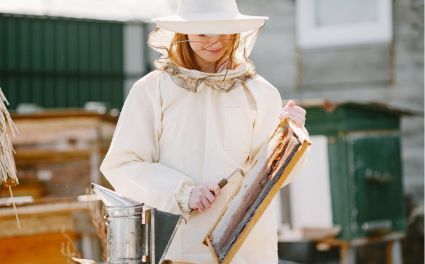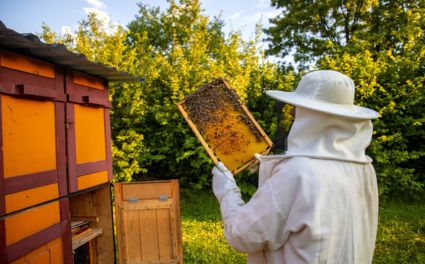The Silent Invasion: Are Your Hives at Risk?
Bees friends know that protecting their hives is a constant battle, but what if the greatest threat isn’t disease or harsh weather? What if it’s an aggressive predator that specifically targets honeybee colonies? Asian hornet invasion isn’t just a minor inconvenience, it’s a full-scale assault on beekeeping.
If you haven’t spotted one near your apiary yet, don’t assume you’re in the clear. These hornets are expanding their territory at an alarming rate, and your hives could be next.
What Does An Asian Hornet Look Like? Don’t Mistake It for A Native Species
One of the biggest mistakes beekeepers make is failing to recognize an Asian hornet before it’s too late. They can be confused with European hornets, but there are key differences to watch for. Asian hornets have a sleek, dark brown or black body with vibrant yellow-orange bands and striking yellow-tipped legs. Their heads are a distinctive orange, and their aggressive behavior sets them apart from other hornet species.
If you notice one hovering near your hives, it’s not just passing by—it’s hunting. Immediate action is crucial to prevent a full-scale attack on your colonies.
Asian Hornet Population Explosion: Why Are They Spreading So Fast?
How did these hornets become such a global problem? The answer lies in their ability to reproduce and adapt to new environments. Originally from Southeast Asia, they have spread rapidly through Europe and other regions, thanks to their highly efficient reproductive cycle.
A single-mated queen emerges in spring and establishes a nest, which can grow to house thousands of hornets by late summer.
These colonies don’t just grow—they multiply. In autumn, dozens of new queens leave the nest to overwinter, each capable of starting a fresh colony the following year. This rapid population growth means that beekeepers must remain vigilant, as the number of hornets in any given area can increase dramatically within just a few seasons.

How Do Asian Hornets Attack Beehives? Learning Their Deadly Tactics
If you’ve ever seen an Asian hornet in action, you know they are not mindless killers—they are strategic, efficient, and devastatingly effective at wiping out honeybee colonies.
The Hawking Method: Picking Off Bees One By One
Asian hornets don’t waste energy storming a hive right away. Instead, they hover just outside the entrance, waiting for unsuspecting bees to exit. As soon as a bee emerges, the hornet strikes, snatching it mid-air. It then dismembers the bee, carrying the protein-rich thorax back to its nest to feed the developing larvae.
Mass Invasions: When A Hive Becomes Overwhelmed
If a hive is weak or under heavy attack, the hornets can switch to an all-out invasion. Dozens of hornets swarm in, killing guard bees and ripping through the colony. Within hours, they can completely decimate a hive, leaving nothing behind but destruction.
Once an apiary is targeted, it remains on the hornets’ radar, and attacks will persist unless serious countermeasures are taken.
Protecting Your Hives: The Best Tools For The Job
Beekeepers aren’t defenseless in this fight. The right tools and strategies can mean the difference between a thriving hive and complete devastation.
Suit Up: Protect Yourself First
Asian hornet stings are painful and can be dangerous, especially if you get stung multiple times. A standard suit won’t cut it. The Ventilated Beekeeping Suit by OZ Armour delivers reinforced protection, making sure that even the most aggressive hornets can’t reach your skin. When dealing with an invasion, your safety comes first. You can also explore our 3-Layer Khaki Beekeeping Suit for added durability and comfort.
Set Traps Before They Take Over
An infestation can be prevented before it begins with early detection. The hornet monitoring trap is designed to lure in and capture scout hornets before they alert their colony about your apiary. Placing these traps strategically around your hives can make a significant difference in reducing the threat.
Secure The Hive Entrance
Since Asian hornets rely on targeting bees as they leave the hive, controlling hive access is key. The hive guard entrance reducer helps regulate entry and exit points, giving honeybees a fighting chance against attacks.
Removing A Hornet Nest: What You Need To Know
If you discover an Asian hornet nest near your property, it’s best to call professionals. Moreover, if removal is necessary, don’t attempt it without proper gear. A hornet removal kit—complete with beekeeping gloves, a reinforced suit, and a beekeeping smoker—gives you the best possible defense when dealing with an active nest.
What Can Beekeepers Do To Stop The Spread Of Asian Hornets?
Fighting the Asian hornet threat isn’t just about protecting individual hives—it requires a community-wide effort. Here’s what every beekeeper should be doing:
Report Sightings Immediately
Authorities need accurate data to track and control hornet populations. If you see one, document it and notify local beekeeping associations.
Collaborate With Other Beekeepers
Share strategies, set up traps collectively, and work together to protect apiaries in your area. Consider equipping your team with complete beekeeping kits with suits to stay prepared.
Stay Informed
Asian hornets are constantly spreading, and new defense strategies are always emerging. Keeping up with the latest research and gear—such as beekeeping smokers and beekeeping equipments—can help you stay ahead of the threat.

Your Hive, Your Responsibility!
Asian hornets aren’t going anywhere, and waiting until you experience an attack firsthand is a dangerous gamble. Their numbers are growing, their hunting tactics are brutal, and they pose a serious risk to beekeeping worldwide. But you don’t have to sit back and let them take over.
By staying vigilant, investing in protective gear, and using proven defense strategies, you can stand up to this invasive predator and protect your hives.
Act now! Equip yourself with OZ Armour’s beekeeping suits, including options for beekeeping kids suits, beekeeping pink suits, beekeeping veils, and more to ensure everyone in your apiary stays safe.
🧠 Want more insights? Read more blogs about beekeeping and stay one step ahead.




